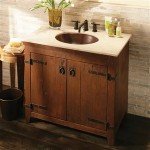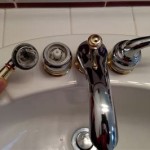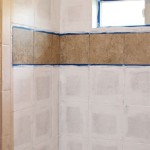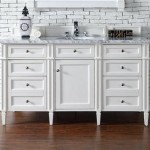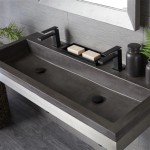How Much Did It Cost To Install A Bathroom Vanity?
Determining the average cost to install a bathroom vanity is a complex endeavor, influenced by a multitude of factors ranging from the type of vanity itself to the regional labor market. The total expense typically encompasses the cost of the vanity unit, any required plumbing adjustments, electrical modifications (if applicable), removal and disposal of the old vanity, and the labor charges associated with the installation process.
A basic breakdown of costs will involve the vanity itself, which can range from several hundred dollars to several thousand, depending on materials, size, and design. Installation labor can add another significant expense, typically ranging from a few hundred dollars to over a thousand, based on the complexity of the installation and local labor rates. Additional expenses, such as new plumbing fixtures, electrical work, or modifications to the existing bathroom layout, will further contribute to the overall cost.
Before embarking on a bathroom vanity installation project, it is essential to understand the various elements that impact the final price. By considering these factors, homeowners can develop a realistic budget and make informed decisions throughout the process.
Vanity Type and Material
The type and material of the bathroom vanity are major determinants of its price. Prefabricated, off-the-shelf vanities are generally the most economical option. These units are mass-produced and readily available at most home improvement stores. They come in a variety of sizes and styles, offering a budget-friendly solution for homeowners seeking a quick and straightforward upgrade.
Conversely, custom-built vanities represent the higher end of the price spectrum. These vanities are designed and constructed to meet specific requirements, allowing for personalized dimensions, materials, and features. The use of high-end materials like solid hardwood, rare stones, or intricate details significantly increases the overall cost. Opting for a custom vanity is ideal for homeowners seeking a unique and luxurious design that perfectly complements their bathroom's aesthetic.
Semi-custom vanities offer a middle ground between pre-fabricated and custom options. These vanities allow for some degree of customization, such as choosing from a limited selection of door styles, finishes, and hardware. Semi-custom vanities provide a balance between personalization and affordability.
Vanity materials also have a significant impact on cost. Solid wood vanities, particularly those made from hardwoods like maple, cherry, or oak, tend to be more expensive than those constructed from engineered wood products like MDF (medium-density fiberboard) or particleboard. Solid wood offers superior durability and a more luxurious aesthetic, while engineered wood products are more budget-friendly and often resist moisture better.
The countertop material is another factor influencing the cost. Laminate countertops are typically the most economical option, while granite, quartz, and marble countertops are considerably more expensive. The choice of countertop material will depend on the homeowner's budget, desired aesthetic, and durability requirements.
Labor Costs and Complexity of Installation
Labor costs constitute a significant portion of the total bathroom vanity installation expense. These costs vary depending on the local labor market, the plumber or contractor's experience level, and the complexity of the installation. A straightforward vanity replacement, where the new unit has the same dimensions and plumbing connections as the old one, will typically incur lower labor costs than a more complex installation involving plumbing modifications, electrical work, or structural changes.
Plumbing modifications are often necessary when the new vanity has a different size or configuration than the old one. This may involve relocating water supply lines, drain pipes, or both. Such modifications require the expertise of a licensed plumber and can significantly increase the labor costs. Electrical work is necessary if the vanity includes integrated lighting or electrical outlets. This work must be performed by a qualified electrician to ensure safety and compliance with local building codes.
Removing an old vanity can also add to the labor costs, particularly if it is heavily damaged or difficult to access. Disposal fees for the old vanity unit may also apply. Structural changes, such as reinforcing the floor or wall behind the vanity, may be necessary if the new unit is significantly heavier or larger than the old one. These changes will require additional labor and materials, further increasing the overall cost.
The preparation of the installation area also affects labor costs. If the existing floor or wall covering needs to be repaired or replaced before the vanity can be installed, this will add to the overall expense. Ensuring the installation area is level and free of obstructions is crucial for a successful and aesthetically pleasing installation.
Additional Costs and Considerations
Beyond the basic vanity unit and installation labor, a number of additional costs and considerations can impact the overall price of a bathroom vanity installation project. These factors should be carefully evaluated to develop a comprehensive and accurate budget.
New plumbing fixtures, such as faucets, drains, and shut-off valves, are often purchased along with a new vanity. These fixtures come in a wide range of styles and prices, so homeowners should carefully consider their options to find fixtures that complement their vanity and meet their budgetary requirements. New electrical outlets or lighting fixtures may also be required, depending on the design of the new vanity. The cost of these items will depend on their style, features, and brand.
Building permits may be required for certain bathroom renovations, particularly those involving plumbing or electrical work. The cost of a building permit varies depending on the municipality and the scope of the project. It's important to check local building codes and regulations to determine whether a permit is necessary.
Unexpected problems, such as hidden water damage or structural issues, can arise during the installation process. It is wise to set aside a contingency fund to cover these unforeseen expenses. Having a buffer in the budget can prevent the project from derailing due to unexpected costs.
The geographical location also plays a role in installation costs. Major metropolitan areas with higher costs of living will generally have higher labor rates than rural areas. Supply chain issues and material availability can also vary by location, impacting the cost of the vanity unit and related materials. Obtaining quotes from multiple contractors in the local area can provide a more accurate estimate of the expected costs.
Finally, the timing of the installation can influence the cost. During peak renovation seasons, such as spring and summer, contractors may be in higher demand and charge higher rates. Scheduling the installation during the off-season, such as fall or winter, may result in lower labor costs, but could be impacted by weather-related delays.

Bathroom Vanity Installation Cost 2024 Average S

Bathroom Vanity Installation Cost 2024 Average S

How Much Does It Cost To Install A Bathroom Vanity 2024 Bob Vila

2024 Vanity Installation Cost A Complete Guide

Bathroom Vanity Replacement Cost Interunet

How Much Does Bathroom Vanity Installation Cost 2024

Fixr Com Sink Installation Cost New

How Much Does Bathroom Vanity Installation Cost 2024

How Much Does It Cost To Install A Bathroom Vanity

How Much Does Bathroom Vanity Installation Cost 2024
Related Posts
